 |

| |
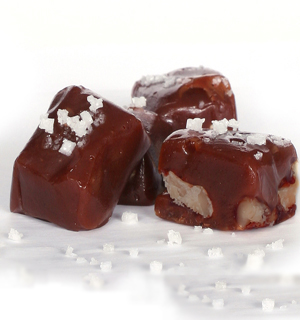
Handmade Chocolate & Walnut Salted Caramels from Das Foods bring new flavor elements to the caramel of yore. |
| WHAT IT IS: Sea salt caramels made with Fleur de Sel, the famous sea salt from Brittany. |
| WHY IT’S DIFFERENT: The salted caramels are infused with a secondary flavor—chocolate, coffee, ginger, lavender, lemon, orange and sometimes nuts on top of that. The layers of flavor last long on the palate, after the buttery caramel has dissolved, along with some crunchy flakes of salt. |
| WHY WE LOVE IT: Innovative, exciting and a little more than 30 calories a piece for a lot of flavor. |
| WHERE TO BUY IT: DasFoods.com |
|
|
 |

Das Caramelini:
Sweet ‘n’ Salty ‘n’ Buttery, Too
If you’re a student of languages, the label may seem a bit strange: the German pronoun “Das” modifying the Italianate “Caramelini.” But Das Caramelini turn out to be salted caramels made by Katie Das of Das Foods—and they are outstanding. If the concept of a salty caramel is foreign to you, it’s a classic French confection that has become popular on these shores with the growing use of Fleur de Sel and other sea salts (read all about them in our Salt Glossary). The combination of sugar, salt and butter is magnificent on the palate. Dare we say it—we’d rather have a great salt caramel than a piece of chocolate.
Ms. Das is pleased to oblige, with not only salted caramels (the terms “salt caramel” and “salted caramel” are used interchangeably), but infusions of seven wonderfully natural flavors. The salt caramel collection includes Café Cortado, Chai Latte, Chocolate & Walnut, Classic (Lavender), Ginger & Pistachio, Lemon & Honey and Orange & Honey. The caramels are gluten free and have only 32 calories or so apiece, depending on the flavor. The four-ounce boxes make great stocking stuffers...and have made Das Caramelini addicts out of us. We feel good about that because 10% of profits go to the AIDS Foundation of Chicago, which has outreach in the U.S. and abroad. Read the full review below.
|
| |
|
|
THE NIBBLE does not sell the foods we review
or receive fees from manufacturers for recommending them.
Our recommendations are based purely on our opinion, after tasting thousands of products each year, that they represent the best in their respective categories. |
Make Your Own Candy
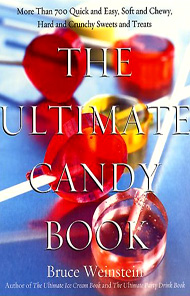 |
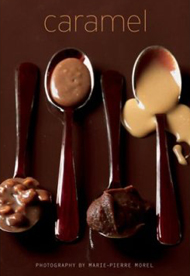 |
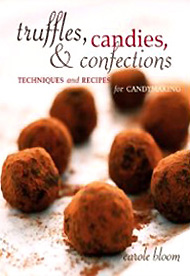 |
| The Ultimate Candy Book: More than 700 Quick and Easy, Soft and Chewy, Hard and Crunchy Sweets and Treats, by Bruce Weinstein. Fudge, taffy, brittle, the works. Click here for more information or to purchase. |
Caramel, by Trish Deseine. The 130 recipes show caramel not just as a dessert, but paired with vegetables and meats as well. Click here for more information or to purchase. |
Truffles, Candies, & Confections: Techniques and Recipes for Candymaking, by Carole Bloom. Go ahead—try the vanilla cream caramels. Click here for more information or to purchase. |
Das Caramels: Sweet ‘n’ Salty ‘n’ Buttery Too
INDEX OF REVIEW
|
MORE TO DISCOVER
|
While toffee and butterscotch are British inventions, made by boiling sugar to a hard-crack stage, Americans created the caramel in the mid-1880s, slow-boiling sugar and milk to create a soft candy. In a world that knew largely hard candy (the chocolate bar wasn’t invented until 1847, and think about it—most people didn’t have such great teeth), soft, chewy caramels had a waiting market. In fact, Milton Hershey originally sought his fortune in caramels, founding the Lancaster Caramel Company in 1886. He learned to make chocolate while looking for new coatings for his caramels. While caramels originated in the U.S., the concept of salted caramels originated in Brittany, on the southern Atlantic coast of France, where Fleur De Sel is harvested. While caramel candies were an everyday treat, salted caramels were considered a delicacy, for more refined palates.
Milk or cream is essential to make a soft caramel rather than a hard candy, as is a fat—butter for fine caramels, vegetable oil for cheap ones. Sugar and vanilla or other flavorings—chocolate, coffee, maple, pecan, etc.—are also needed. The ingredients are mixed, cooked, cooled and formed into bite-size squares or rectangles. Originally, caramels were cooked in a deep copper candy kettle on gas stoves; the confectioner or home cook used a candy thermometer to monitor the temperature, then poured the batch onto a marble slab (or a professional cooling table) to cool and harden before scoring the caramel into squares. Many artisan caramel makers carry on this tradition.
While the ingredients for caramel may seem simple, available in everyone’s kitchen, making caramels at home is not the easiest undertaking. It requires practice, and a recipe is only the starting point. Too much sugar makes the caramel grainy, too much moisture makes it tacky, too little moisture at too high a heat makes it too chewy.
In large production lines, sophisticated machinery with temperature and moisture controls is carefully calibrated; on a home stove, it takes experience and luck. Professional artisan caramel makers (and good home candy makers) have thrown out so many flawed batches in their years of perfecting their skills, that they now know just by the look, smell and feel of a batch if there is any slight variation that may result in an inferior product. Timing is everything: An extra two or three minutes on the stove creates toffee. |
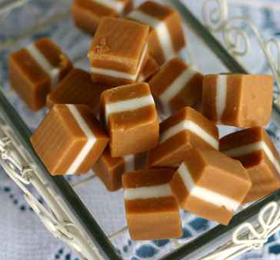
Familiar commercial caramels, machine cut into perfect cubes. Don’t try this at home! Photo by Nicolette Neish | Fotolia. |
There are caramels and there are caramels. The finest artisan caramels are made of cream (“cream caramels”), while mass brands use condensed milk; artisans use butter, mass producers use vegetable oil; artisans use sugar, and some high-quality corn syrup to prevent graininess; mass producers use lower-quality corn syrup; artisans use all natural flavors, mass-producers use vanillin, artificial vanilla, and other artificial flavors instead of natural ones. Corn syrup, which is less expensive than sugar, provides sweetness to the candy batch and can also prevent crystallization (graininess)—especially important for shelf life). Corn syrup also lends body. At least one fat is added to the mixture as well. Butter is often the only fat added by gourmet caramel makers as it provides superior taste, but this proves to be very expensive for mass-production. So other fats are added along with a fairly small amount of butter. As maple caramels or other flavored caramels are produced, the ingredients vary accordingly. All caramels contain soy lecithin, an emulsifier that helps prevent the caramels from sticking to the wrapper.
The Difference Between Caramels, Butterscotch & Toffee
Caramels are the softest, butterscotch is harder and toffee is the hardest of the three, based on both ingredients and how hot the ingredients are boiled. Caramels are boiled to the firm-ball stage on a candy thermometer (248°F), butterscotch is boiled to the soft-crack stage (270° to 290°F) and toffee to a hard-crack (295° to 310°F). (If you’re a toffee lover, read more about toffee here.)
The ingredients vary slightly. Butterscotch and toffee are made by combining sugar, butter and water; butterscotch (an American creation) an American-style toffee, as opposed to English toffee, can add vanilla and other flavorings. The key difference is that caramels add milk or cream to the recipe. That, along with the lower heat, creates the softer, chewier candy.
If you’re into science, the color of caramels comes from a reaction between the sugar and an amino acid in the milk or cream. Called the Maillard (my-YARD) reaction after the French physician and chemist Louis Camille Maillard, it’s a form of non-enzymatic browning that usually requires heat. Each type of food has a very distinctive set of flavor compounds that are formed during the Maillard reaction. The color and flavor of toasted bread and nuts; barbecued, roasted and seared meats; and roasted coffee (and many others) are the result of Maillard reactions. The process called caramelization—the caramelization of sugar, not the creation of caramels—is not a Maillard reaction but a different type of non-enzymatic browning, not involving amino acids. Instead, the sugar is oxidized.* Enough science for you? Let’s get back to caramels.
*Information from Wikipedia.
Das Foods: Philosophy
The company is committed to artisan craftsmanship—even the imperfection of hand-wrapping, as opposed to the perfection of a machine-wrapped caramel, lets you know these product were made by hand.
The caramels are handmade using the freshest ingredients. The fresh cream, butter and natural honey used are procured from small, sustainable farmers in the midwest (Das Foods is based in Chicago). The company seeks out sustainably-grown nuts and fruits. The caramels are all natural, preservative-free and trans fat-free.
|
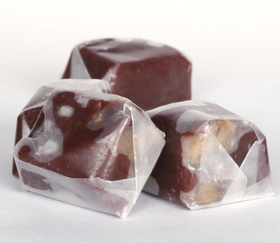 |
Caramelini Flavors
Caramels are made with sweet butter, but some French confectioners have traditionally made them with salted butter (caramel au beurre salé) to achieve the sweet-salty pairing. Using sea salt in a caramel recipe is different from using salt butter to make caramel au beurre salé. The sea salt doesn’t melt into the caramel, so there are fine grains of salt that add texture and crunch. If it sounds like too much salt, it isn’t: We never salt our food, and this is one of our favorite confections. The caramels melt in your mouth. People who have had dental surgery, wear braces or dentures, or otherwise wouldn’t consider a caramel could eat one of these (the nutless flavors, anyway).
The caramels are one inch by ¾ inch wide by ½ inch deep—a satisfying size because they are so packed with flavor. In addition to salt caramel butteriness, they’re infused with secondary flavors. The flavor envelops like a fine wine: first the caramel, then the butter, then the infused flavor. When they’ve all dissolved, a couple of salt crystals remain to provide a bit of crunch and a wonderful note of fine salt to balance the sweetness.
And the flavors are so fresh—as if you’d eaten some lavender or orange along with the caramel. In one case, you do eat the item—so let’s move on to our first flavor.
- Café Cortado Salted Caramels. Named after a coffee drink made with heavy cream, this is the most spectacular flavor, and it will drive coffee lovers wild. It’s the most textured, thanks to the large fragments of crushed coffee beans that you can see swimming in the translucent caramels. Starbucks, take note: You will want to lay in a large stock of these, because they will sell out like crazy.
- Candied Ginger & Pistachio Salted Caramels. The combination of flavors works really well; after the third caramel, we had a delightful ginger buzz going. Both the pistachio nuts and the candied ginger are present in tiny pieces, not the large ones shown in the photo, because the whole pistachios proved hard to work with.
- Chai Latte. We didn’t get to taste this flavor this time around—but, chai lovers that we are, we have something to look forward to with our next order.
|
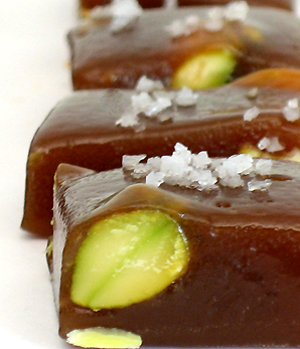
Candied Ginger & Pistachio Salted Caramels. After the caramels are wrapped, the salt migrates inside the caramel. |
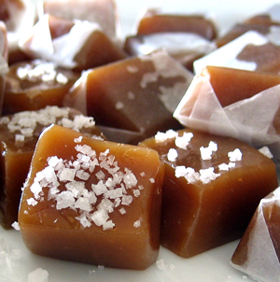
Orange & Honey Salt Caramels—one of our favorites. Fleur de Sel is not salty like regular table salt—it has a very delicate flavor and crunch. |
- Chocolate & Walnut Salted Caramels. This is a top seller. It’s certainly good, but probably ranks as our least favorite flavor in terms of sheer gloriousness. The chocolate flavor is light and pleasant—no one will hesitate to finish the entire box, and we’d gladly take another. It’s a personal thing, but we prefer the more intensely chocolate salt chocolate caramels from Béquet Caramels (a chewier style).
- Classic Salted Caramels. The somewhat misnamed Classic is actually lavender-flavored (“Classic” should be a plain salt caramel), and it is splendid. We love lavender and were in caramel heaven.
- Lemon & Honey Salted Caramels. Lemon and butter burst in your mouth. A great combination, as is the Orange & Honey.
|
- Orange & Honey Salted Caramels. You’d swear you’d popped a fresh orange segment in your mouth, along with the caramel—and a pinch of sea salt. The taste is uplifting—one of our favorite flavors.
New flavors are under development—we can’t wait! The caramels have a shelf life of four months at room temperature, one year in the refrigerator (you need to let them come to room temperature for an hour before eating). They can be frozen for up to two years. But that’s not the point. The point is: Try all the flavors, decide upon your favorites and reorder regularly!
Discover how spectacular caramels can be. You may decide you don’t like chocolate that much, after all.
—Karen Hochman
FORWARD THIS NIBBLE to anyone who likes sweets or is looking for terrific stocking stuffers.
DAS CARAMELS
Artisan Caramels In Café Cortado, Chai Latte, Chocolate & Walnut, Cinnamon & Honey, Classic, Ginger & Pistachio, Lemon & Honey, Orange & Honey
- 4-Ounce Box
14 to 15 Pieces
$5.99
- Holiday Assortment Box
Keepsake Box With Three Flavors
$21.00
- Candle & Caramel Gift Boxes
4 Boxes Caramels, Scented Candles
$30.00
Purchase online at DasFoods.com
Prices and product availability are verified at publication but are subject to change. Shipping is additional.
|
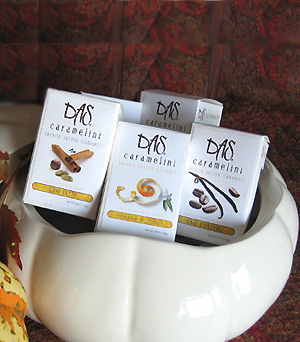
|
Read more about our favorite
sweets:
|
Check Out These Other “Top Pick Of The Week” Candies:
|
FOR ADDITIONAL INFORMATION, special offers,
contests, opinion surveys, THE NIBBLE
back issues archive, product gift-finder, links to our favorite
food websites, and the ability to nominate your favorite nibbles,
visit the home page of TheNibble.com.
Do you have friends who would enjoy THE NIBBLE?
Click here to send them an invitation to sign up for their own copy. |
© Copyright 2004-2026 Lifestyle Direct, Inc. All rights
reserved. All information contained herein is subject to change at any time
without notice. All details must be directly confirmed with manufacturers, service
establishments and other third parties. The material in this e-zine may not
be reproduced, distributed, transmitted, cached, or otherwise used, except with
the prior written permission of Lifestyle Direct, Inc.
|
 |
|
 |











